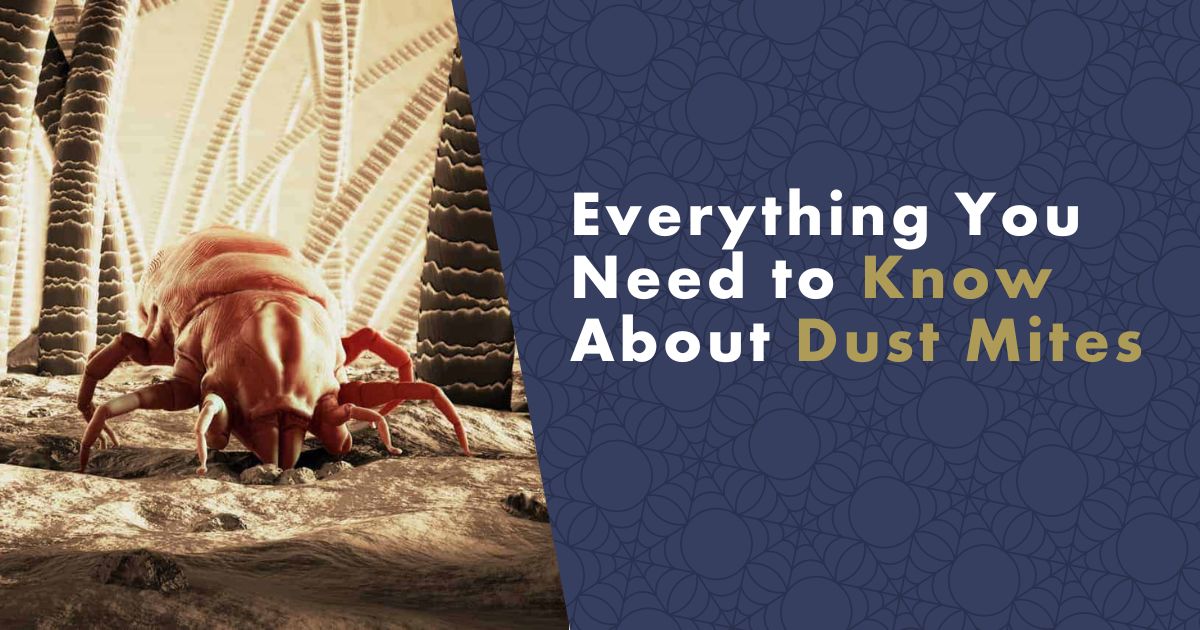To begin with, it's important to acknowledge that dust mites are present in every household, and you have likely coexisted with them in the past, present, and future. The mere presence of dust mites is not necessarily indicative of poor cleanliness. However, the level of cleanliness can affect the abundance of these tiny creatures. If you have an allergy to dust mites, it's crucial to maintain a controlled amount of them in your living space, as they can trigger a range of allergic reactions.
Tip: Read the article on how to know if you have an allergy.

What Are Dust Mites?
Dust Mites belong to the order Arachnida and are tiny creatures, typically ranging in size from 80 nanometers to 1 millimeter. Due to their small size, they are not visible to the naked eye. However, their presence can be a nuisance, especially for people with allergies. There are over 50,000 known species of dust mites worldwide, and although they have short lifespans, they reproduce quickly.
Dust Mites can be found in households and can survive for several weeks under suitable conditions. During this time, they mate multiple times, allowing them to multiply rapidly. Dust Mites have an unsegmented body, with the first pair of limbs forming either claws or needles known as chelicerae. While they are classified as arachnids, not all species have eight legs, with some having only two pairs. Their diet consists of dead human skin, fungi, bacteria, yeasts, and even the bodies of their own species.
What Environments Do They Thrive In?
Dust Mites thrive best in environments that are in close proximity to humans, as they have access to a continuous food supply in the form of flakes of human skin. Due to the fact that we spend a considerable amount of time in bed, it serves as the optimal habitat for these creatures, with bedding, mattresses, and bed linen being areas with the highest concentration of dust mites. However, they can also be found in large numbers in the air, upholstery, and curtains.

The population of dust mites can range from millions to tens of millions, indicating the massive numbers in which they exist. These creatures are not picky about their habitats, as they can also be found in upholstery on sofas or chairs, wardrobes, carpets, curtains, and even plush toys. Dust Mites are commonly found in dust as well, with research showing that every gram of dust can contain anywhere between 2,000 to 15,000 of them. Furthermore, studies have revealed that after two years of use, up to 10% of a typical pillow's weight can be attributed to dust.
Tip: Do you think you have a dust allergy? You can read more about this allergy in the article.
Are Dust Mites Harmful? Understanding the Impact of Dust Mites on Human Health
Dust mites produce allergenic droppings that can cause a range of allergic reactions such as stuffy nose, chronic runny nose, cough, or atopic eczema. It is worth noting that a "dust allergy" is, in fact, a dust mite allergy. To confirm if you have a dust mite allergy, you can take a home allergy test or seek professional help from an allergist.
Tip: Are you allergic to dust mites? We'll show you how to fight her. Read our article.
Is It Possible to Get Rid of Dust Mites?
Dealing with dust mites requires a more nuanced approach than dealing with an ordinary spider, which can be either gently released outside in a jar or disposed of by squashing it with a slipper. Killing dust mites doesn't necessarily eliminate the problem, as their dead bodies can still serve as a source of food for other dust mites.
Therefore, it's important to approach mite extermination with care, as harsh insecticides or excessive cleaning can do more harm than good. Regular hygiene practices, household disinfection, and using specialized bedding and covers can be more effective in managing dust mites.
#produkty#https://www.nanospace.store/anti-dust-mite-bedding/
Sources:
- Arlian LG, A. A. (n.d.). Lowering humidity in homes reduces dust mites and their allergens. J Allergy Clin Immunol, 99-104.
- Arlian LG, N. J.-M. (1999). Reducing relative humidity to control the house dust mite Dermatophagoides farinae. J Allergy Clin Immunol, 852-6.
- Ellingson AR, L. D. (1995). The prevalence of Dermatophagoides mite allergen in Colorado homes utilizing central evaporative coolers. Ann Allergy, 680-3.
- R Voorhorst, F. S. (1967). House dust mite atopy and the allergens it produces: identity with the house dust allergen. J Allergy, 325-329.
- RL Brandt, L. A. (1976). Mortality of house dust mites, Dermatophagoides farinae and D. pteronyssinus exposed to dehydrating conditions or selected pesticides. JMed Entomol, 327-352.
- Singh, M., & Jaiswal, N. (2013). Dehumidifiers for chronic asthma. Cochrane Database of Systematic Reviews, 1-25.
- Meltzer EO. Allergic rhinitis: burden of illness, quality of life, comorbidities, and control. Immunol Allergy Clin N Am. 2016;36(2):235–48.
- Kong DL, Qin Z, Shen H, et al. Association of obstructive sleep apnea with asthma: a meta-analysis. Sci Rep. 2017;7(1):4088.
- Kou W, Li X, Yao H, et al. Meta-analysis of the comorbidity rate of allergic rhinitis and asthma in Chinese children. Int J Pediatr Otorhinolaryngol. 2018;107:131–4.
- De Groot EP, Nijkamp A, Duiverman EJ, et al. Allergic rhinitis is associated with poor asthma control in children with asthma. Thorax. 2012;67(7):582–7.
- Pedro GB, Marcelo A, Priscila T, et al. United airway disease: current perspectives. J Asthma Allergy. 2016;9:93–100.
- Lun HK, Min BY, Chan KC, et al. Determinants for asthma control, quality of life and use of complementary and alternative medicine in asthmatic pediatric patients in four cities. World J Pediatr. 2018;14(5):482–91.
- Jung CG, Lee JH, Ban GY, et al. Prevalence and clinical characteristics of local allergic rhinitis to house dust mites. Yonsei Med J. 2017;58(5):1047–50.
- Nurmatov U, van Schayck CP, Hurwitz B, et al. House dust mite avoidance measures for perennial allergic rhinitis: an updated Cochrane systematic review. Allergy. 2012;67(2):158–65.
- Cheng L, Chen J, Fu Q, et al. Chinese Society of Allergy Guidelines for Diagnosis and Treatment of Allergic Rhinitis. Allergy Asthma Immunol Res. 2018;10(4):300-53.
- Sheehan WJ, Phipatanakul W. Indoor allergen exposure and asthma outcomes. Curr Opin Pediatr. 2016;28(6):772–7.

